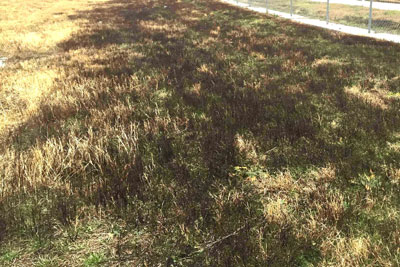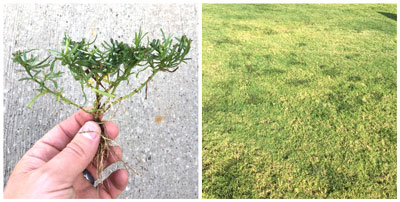Question of the Week 1: September 28, 2017
“Neil, what is this weed, and how can I eliminate it?”
These photos showed up on my Facebook page a few days ago. I told Brian that he was the first to ask about them, but that he wouldn’t be the last. Not by a long shot.
This is roadside aster. It blooms in the fall with nickel-sized, lavender-white flowers. Brian’s plants are days away from coming into bloom.

Photo: Roadside aster flowers are admittedly kinda pretty. For a few days. In somebody else’s yard.
Bees do come to it, so when I write about it on Facebook and try to help people control it, there’s usually an outpouring of angry Texans who think I’m the worst person on earth for giving any advice that leads to killing of “wildflowers.”
And, in the opposite corner, boxing gloves laced up and ready, there are those people who feel there are already ample plants of roadside asters on roadsides and around other homes in the neighborhood – they really don’t want it in their yards.
I’m in the middle of the big fracas, trying to keep the peace among gardeners. So here are the facts in the short form.
What you need to know about this weed…
• Roadside aster is an annual weed. It dies with the first frost and its stubbly stems turn black and unsightly.

Photo: There has been no fire here. The black areas are dead, stubbly stems of old roadside aster plants.
• It is a broadleafed weed. In spite of the tiny size of its leaves, it is not a grass. Therefore it gets lumped into the group simply called “broadleafed” weeds.
• Therefore, roadside aster can be controlled with a broadleafed weedkiller spray (containing 2,4-D, perhaps in tandem with other herbicides). Apply it, if you can, before the plants come into bloom, or at least before they start to set seed.
• Pulling this weed is a thankless task. It roots into the soil firmly and it will hurt your hands as you pull. If you want to remove the clumps physically, use the corner of a well-sharpened hoe to chop through the stem. One swift cut and it will be gone.
• You could probably apply Gallery pre-emergent weediller granules in early March and repeat the application in early June to prevent roadside aster from sprouting, but that would cost a good bit. See the next and final bullet instead.
• Roadside aster is a “weed of neglect.” You’ll always find it in parts of your lawn that are out by the street or back by the alley – places where it’s hard to water and fertilize. If you’ll take just a bit better care of your turf, fertilize it every 8 or 9 weeks, and mow it at the recommended height, the grass will crowd out the weed before it ever gets started.

